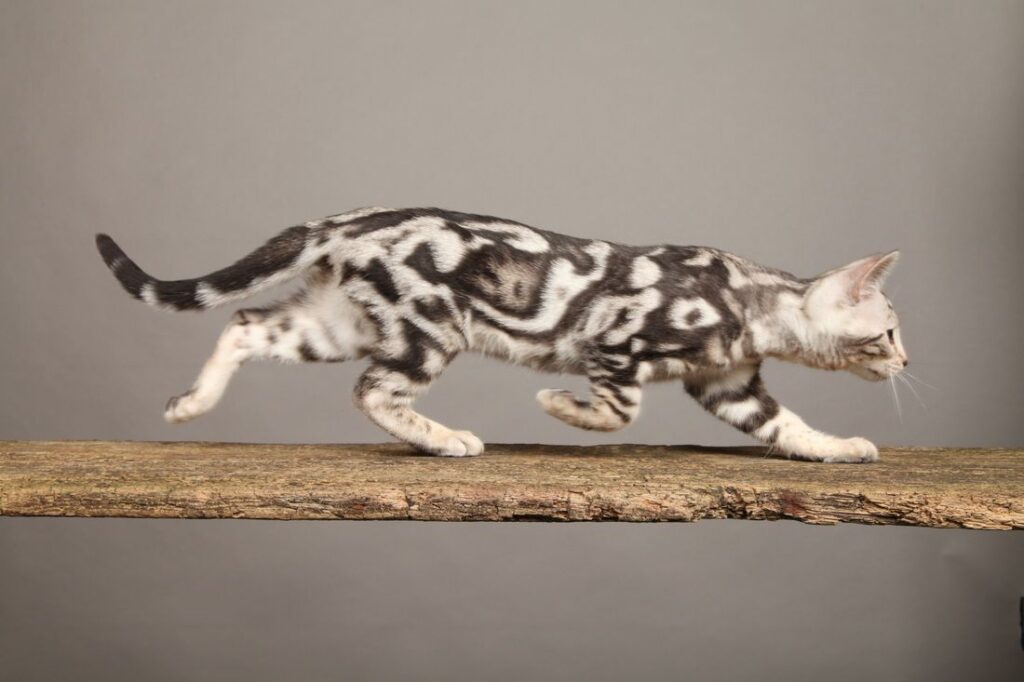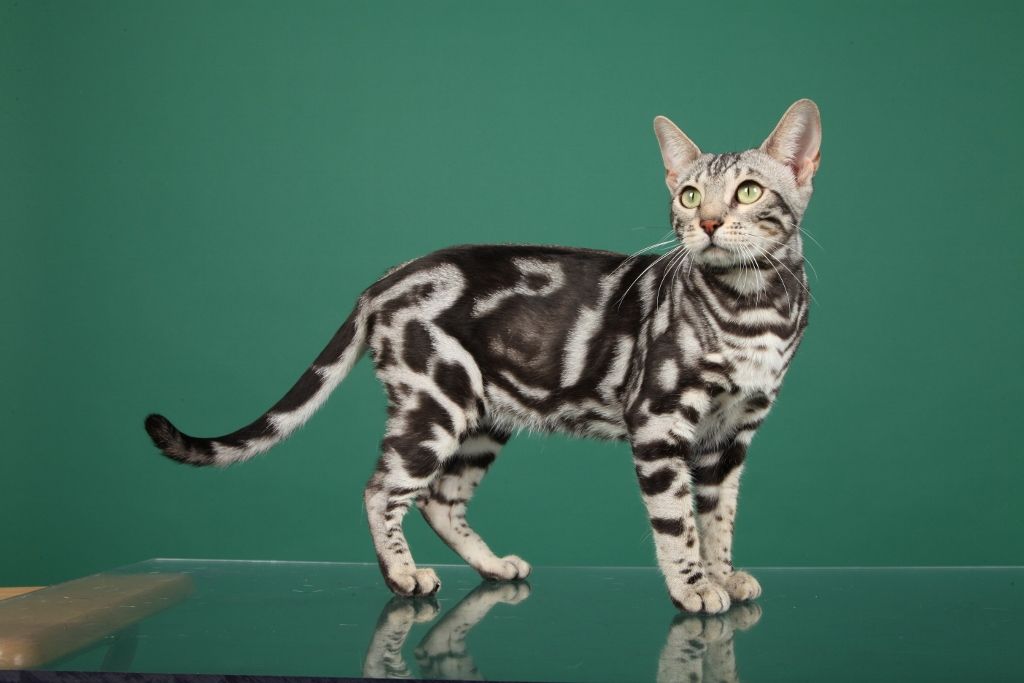Striking, playful, and sociable, a Bengal cat is a great pet to call your own.
Created by breeding a domestic cat and the infamous Asian Leopard Cat, this spotted or marbled beauty looks like a mini-version of a wild kitty.
It is this very trait that gives her the signature looks that we love so much.
Having one is like inviting a jungle cat to your home – only that she will have all traits of a domestic feline.
Bengal cats come in spotted or marbled varieties. The former is the most common pattern with an ocelot or wild leopard look.
The latter is a unique pattern resembling a marble stone with its long wiggly stripes.
If you are crazy about marbled Bengal cats, you have come to the right place. These eye-catchy and sweet cats are worth your love and attention.
Nevertheless, before you own one, you have to know what to expect.
We have put together a comprehensive guide with the ABCs of owning a marbled Bengal cat.
Origin of Marbled Bengal Cats
Before we delve deep into the topic, a short trip to history lane is necessary.
Bengal cats exist today because of the efforts of a few individuals in the past century. These cat enthusiasts dedicated their lives to creating a perfect cross between wild and domestic cats.
Breeders started mating these two diverse felines over 120 years ago but it wasn’t until the 1990s that the breed was perfected and added to cat registries.
One such person is the American conservationist and breeder, Jean Mill. In her bid to protect the Asian leopard cat, she bred it with many domestic cats in the 1970s.
After successfully mating the jungle and house cat, she backcrossed the resulting offspring through a total of five generations to achieve the Bengal cat breed as we know it today.
Initially, Mill was only interested in spotted Bengal cats. So she bred Egyptian Mauis and the Asian leopard cat.
However, the more she carried on, she noticed marbled kittens being produced as well.
The public quickly took note of the new pattern which led to it becoming a breed standard.
In 1987, Millwood Painted Desert – the first marbled Bengal kitten was born to Mill.
The International Cat Association (TICA) recognized Bengal as a breed in 1993.
The Cat Fanciers Association, on the other hand, held off on registering the breed but they finally did so in 2016.
Appearance
A marbled Bengal cat is recognized for his dramatic swirls and horizontal/diagonal stripes on his fur.
The patterns can be single or multi-colored but regardless, they create a sharp contrast with the background color of the cat.
The swirls and stripes essentially come in four varieties: horizontal flow, reduced horizontal flow, sheeted marble patterns, and chaos patterns.
The pattern is displayed once a kitten is born although, at this point, the swirls are more closed.
However, as the cat grows, the swirls open up and reach their full glory at about two years of age.
Possible coat colors of a marbled Bengal cat include black, brown, charcoal, silver, and blue.
The coat itself is short and silky like that of a jungle cat. When the sun shines on it, it becomes glittery. This is because the coat is dotted with translucent hollow hair that reflects light. Its shimmering effect adds to the beauty of the kitty in so many ways.
Common eye colors of the cat include brown, green, orange, and yellow.
Finally, the ears are small-medium and have medium bases and rounded tips while the tail is thick and of medium length.
Besides the coat color, marbled Bengal cats are medium-sized and stay in the range of 10-12 pounds in weight.
With that said, females can weigh as little as 6 pounds while some males go all the way to 18 pounds.
The breed’s long and muscular body makes him appear bigger than he actually is.
His long legs also give him an advantage when climbing walls, furniture, and kitchen counters.
Temperament
With an exotic look, many people shy away from the marbled Bengal cat. If you are one of them, don’t be. This kitty is refined and behaves more like your Ragdoll or Maine Coon.
He is sweet, affectionate, eager to bond with humans, and playful with kids and other pets.
Bengals deeply enjoy the company of kids and other dogs if well-socialized early enough.
Don’t expect your marbled kitty to sit on your lap all the time. Granted, he does it from time to time but he prefers other ways of showing affection.
Bengals also love a lot of attention from their owners. They love being close to them at all times.
When left alone for too long, they can easily get bored and act out. If you plan on being away for most of the day, you might want to get your kitty a buddy to hang out with in your absence.
Energy Level

Marbled Bengal cats are energetic, active, and athletic. These are no breeds for lazy or laid-back people.
They thrive in a home with young kids and plenty of pets to keep them on their toes at all times.
At home, expect your kitty to roam around the house non-stop. He will climb on top of closets, windows, sofas, refrigerators, and any vertical thing for the fun of it.
You will often find him on some high-level watching birds and everything else that catches his eye.
In addition, this cat is extremely agile. Try to rid your counters of breakable items else he will reach those spots and destroy your valuables.
A cat tree with plenty of features will keep him busy for hours. Also, add several toys to stimulate him mentally and physically lest he gets bored.
If you love going on walks, bring him along. As an intelligent breed, he can be taught to use the leash.
Predatory Instinct
Although most of the wild cat traits are absent in marbled Bengals, many of them still have a high predatory instinct.
One of his favorite activities is sitting by the window watching birds and squirrels beneath.
If you have smaller pets – snakes, hamsters, and rabbits at home, don’t keep a Bengal in your house.
These creatures simply have no chance with such a cat around. Prepare to come across an occasional dead mouse or bird in your house from time to time.
Because of their high prey drive, marbled Bengals are best kept at home. When let roam freely, they can wreak havoc on wildlife out there.
Additionally, these cats are not safe outdoors as some people mistake them for feral cats killing them at the sight of one.
Care and Maintenance
Caring for a marbled Bengal cat is pretty straightforward. With a short and glossy coat, his coat doesn’t require much in the way of grooming.
Weekly brushing will remove loose hairs and keep the coat shimmering. Other grooming tasks include nail clipping and oral hygiene for your kitty.
However, the number one need of this cat breed is mental stimulation. Bengals are smart and can be difficult to keep entertained.
You want to introduce your kitty to all kinds of games and toys at a young age.
Get different cat toys and rotate them every week or so to keep him happy.
If you have kids and other pets at home, introduce them to each other early enough to avoid issues in the future.
Marbled Bengals, unlike most cats, are also into water. They enjoy splashing and splashing in pools of water.
You might want to make sure that you give the cat occasional baths and let him enjoy the water as much as he pleases.
Health and Lifespan
All Bengal cats including marbled Bengals enjoy a long lifespan of 9-15 years.
They are pretty much healthy save for a few health conditions the breed is susceptible to.
These include the following:
- Eye Disease: Specifically called progressive retinal atrophy, this eye condition is quite common among marbled Bengal cats. It basically causes the retina part of the eye to deteriorate and eventually go blind.
- Heart Disease: Both spotted and marbled varieties of Bengals are also at risk of hypertrophic cardiomyopathy. The condition thickens the heart muscle causing blood clots and congestive heart failure.
- Anesthetic Allergies: This breed is very sensitive to anesthesia and needs to be monitored closely during surgical procedures such as spaying and neutering. An allergy to anesthetics can cause cardiac arrest.
Cost
A marbled Bengal is no cheap pet. Before you get one, plan your finances well.
A non-show cat can set you back hundreds of dollars. However, if you want a show-quality marbled kitty, don’t be surprised if you spend more than a thousand bucks.
This breed is unique-looking, rare, and not easy to produce. Also, many generations of Bengals are needed to remove any wild traits. This ultimately pushes the price up the roof.
Final Thoughts
A marbled Bengal cat brings a lot to the table. He is affectionate, pleasant to look at, friendly, and intelligent.
Oppositely, he is expensive, gets bored very fast, has a high predatory instinct, and needs a lot in the way of exercise.
Determine if you can trade in these challenges for all the good things this breed can bring to your life.

Hi! I am Eleanor Price. I started this website after my cat, Louie, almost died from a case of botulism (a type of food poisoning often caused by bacteria that grow on food items). Turned out that my cat’s diet was the problem. I have made it my duty to provide the best information and recommendations about everything cat lovers need to know about their felines’ health and wellbeing. My goal is to find the most informative content on anything feline-related and share it with fellow hardworking kitty lovers.

